Steel Products Prices North America

Raw Material Prices: Iron Ore, Coking Coal, Pig Iron, Scrap and Zinc
Written by Peter Wright
April 5, 2019
Raw materials prices have lacked direction in the last month.
Table 1 summarizes the price changes through March of the five materials considered in this analysis. It reports the month / month, 3 months / 3 months and 12 months / 12 months changes and tells us that iron ore and pig iron declined in one month and all except iron ore declined year-over-year. This is almost the same pattern that existed in our February report.
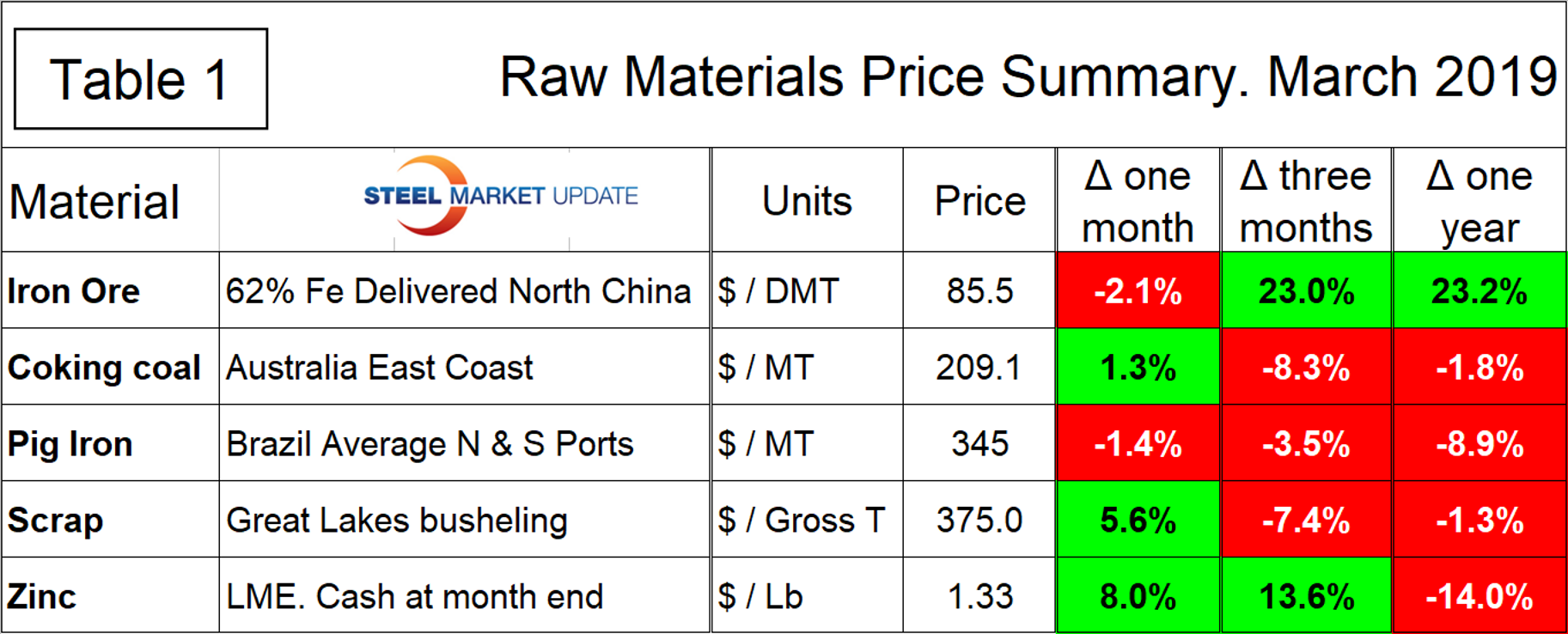
Iron Ore
Based on CRU’s data, the weekly average spot price of 62% fines delivered North China was $85.50 per dry metric ton on March 27. The price declined by $1.80 in the last month, but was up in three months and year-over-year. Figure 1 shows the price of 62% Fe delivered North China since January 2009. The price of ore has broken out of the $20 range that prior to February 2019 had existed for a year and a half.
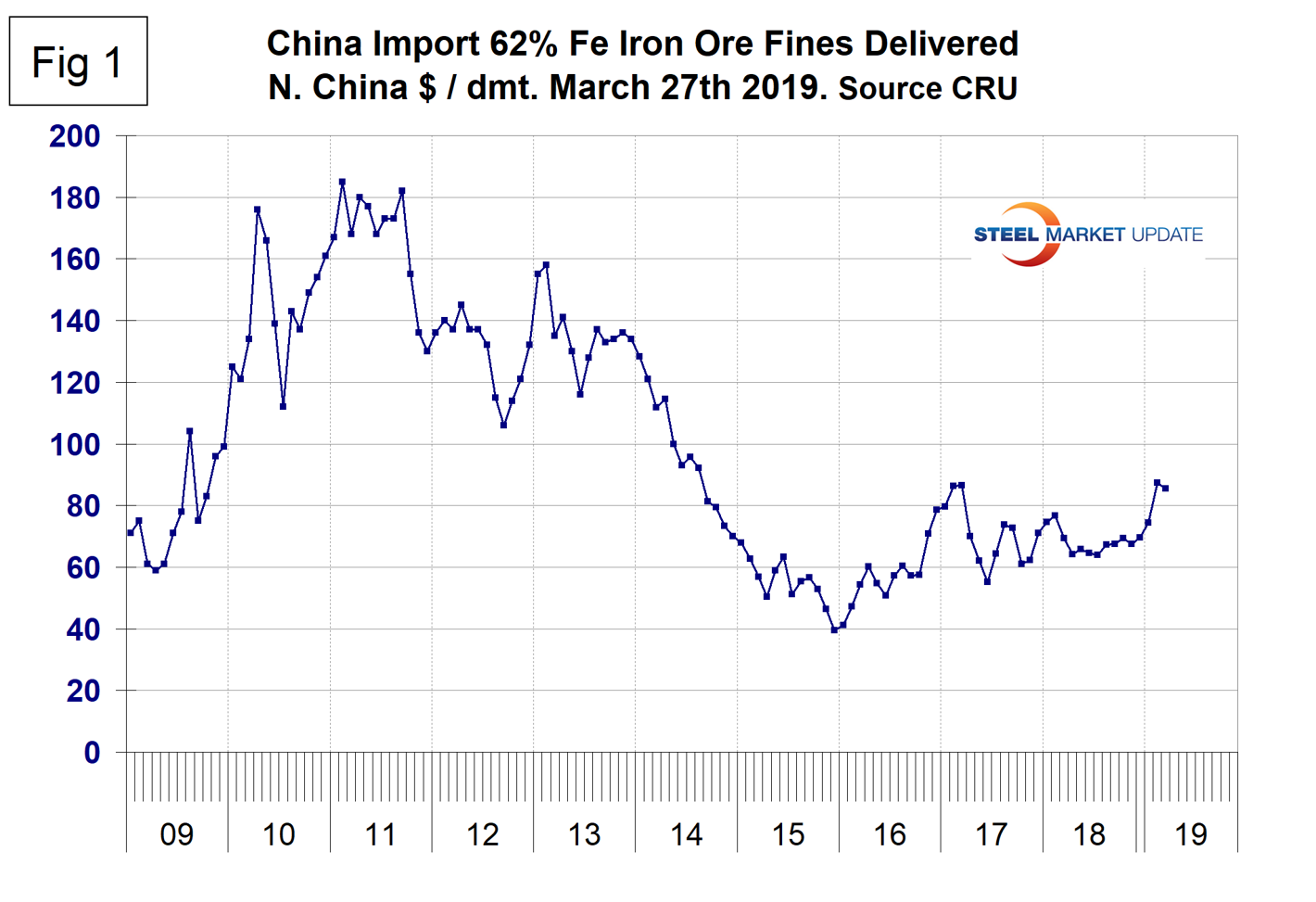
From Mining.com March 25: “Operations at Brucutu, the largest iron ore mine in the Brazilian state of Minas Gerais, have been halted for over a month as part of intense scrutiny from global and local authorities on Vale’s operations following January’s dam collapse at the company’s Corrego do Feijão mine, which left at least 300 people dead. The company has also shut down its Alegria mine, in the Mariana complex of Minas Gerais state, which may remove up to 10 million tonnes of iron ore a year from the market. It also follows yet another massive evacuation of the communities located by Vale’s Sul Superior Dam at the Gongo Soco mine, which was found to be in a critical condition in terms of stability.”
Coking Coal
The price of premium low volatile coking coal FOB east coast of Australia rose in both February and March reaching $209.10 / metric ton on March 27. The price has ranged between $179.50 and $235 / mt since October 2017. (Figure 2)
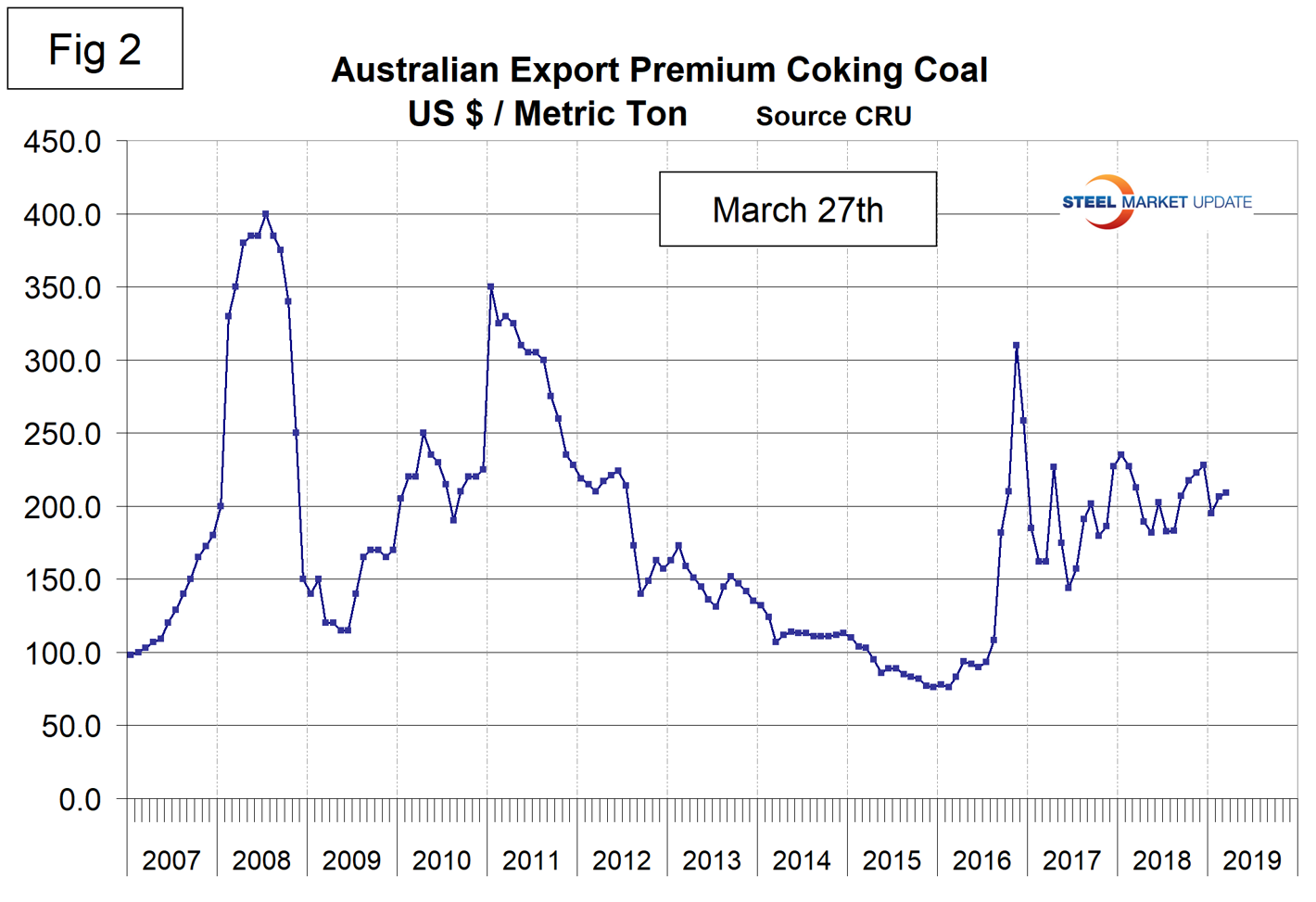
From Mining.com on March 18: “China’s unofficial go-slow on clearing Australian coal through customs didn’t show up in the first two months of this year, but it may now be starting to have an impact. Chinese coal traders are reported to have cut back on buying from Australia, the world’s largest exporter of the fuel, after the length of time taken by customs to clear cargoes reportedly doubled to at least 40 days. The concern that China was restricting Australian coal imports led to a drop in the Australian dollar and weaker coal prices at the main export port of Newcastle.”
Pig Iron
Most of the pig iron imported to the U.S. currently comes from Russia, Ukraine and Brazil with additional material from South Africa and Latvia. In this report, we summarize prices out of Brazil and average the FOB value from the north and south ports. The price steadily increased from the $175 low point in February 2016 to $400 in May and June 2018 before declining to $345 in March 2019. The average price in March was 8.9 percent lower than in March last year (Figure 3).
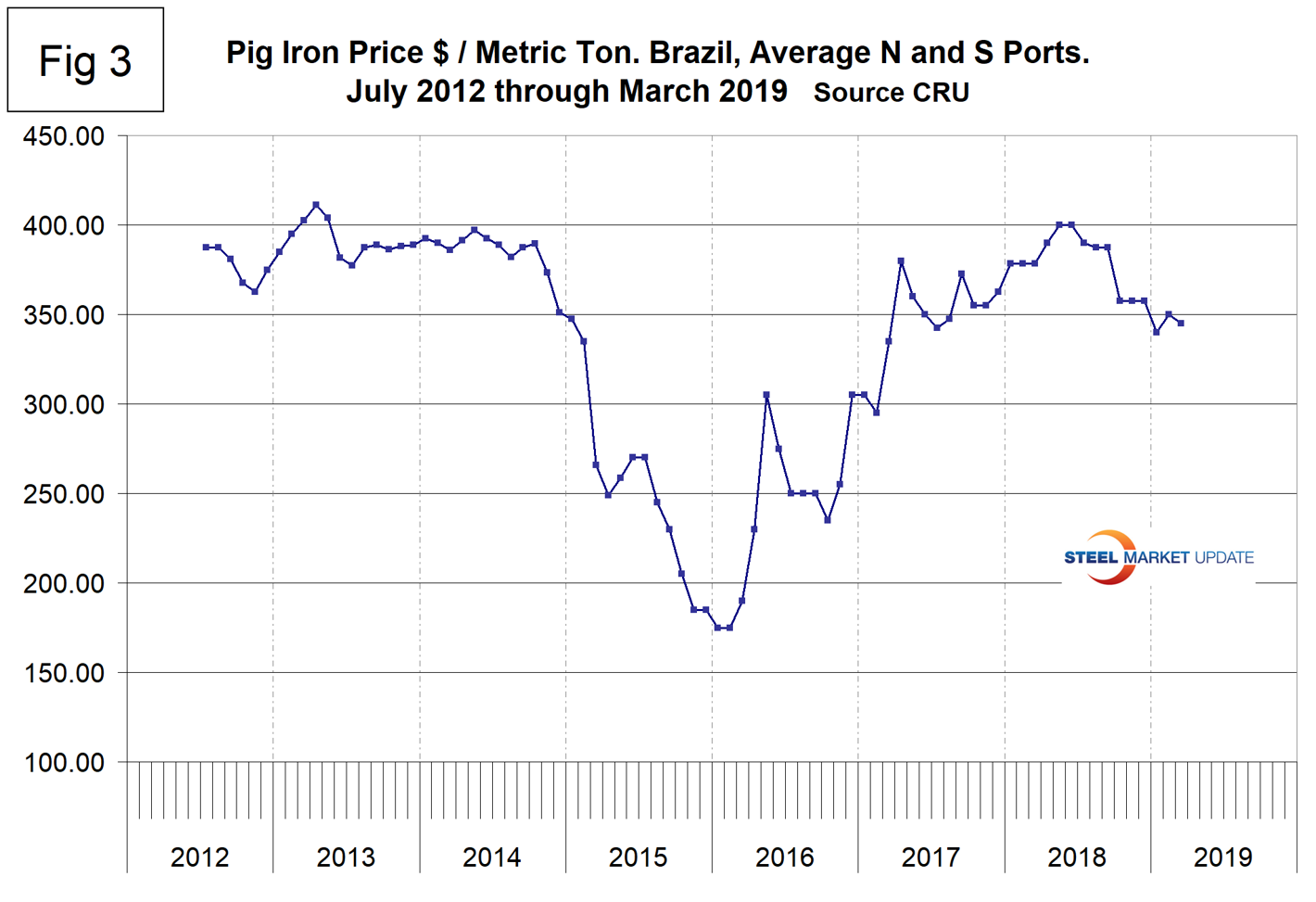
Scrap
To put this raw materials commentary into perspective, we include here Figure 4, which shows the spread between busheling in the Great Lakes region and hot rolled coil Mid West U.S. through mid-March 2019, both in dollars per net ton. The spread has collapsed from $564 in August last year to $364.18 in March and is approaching a more historically normal range.
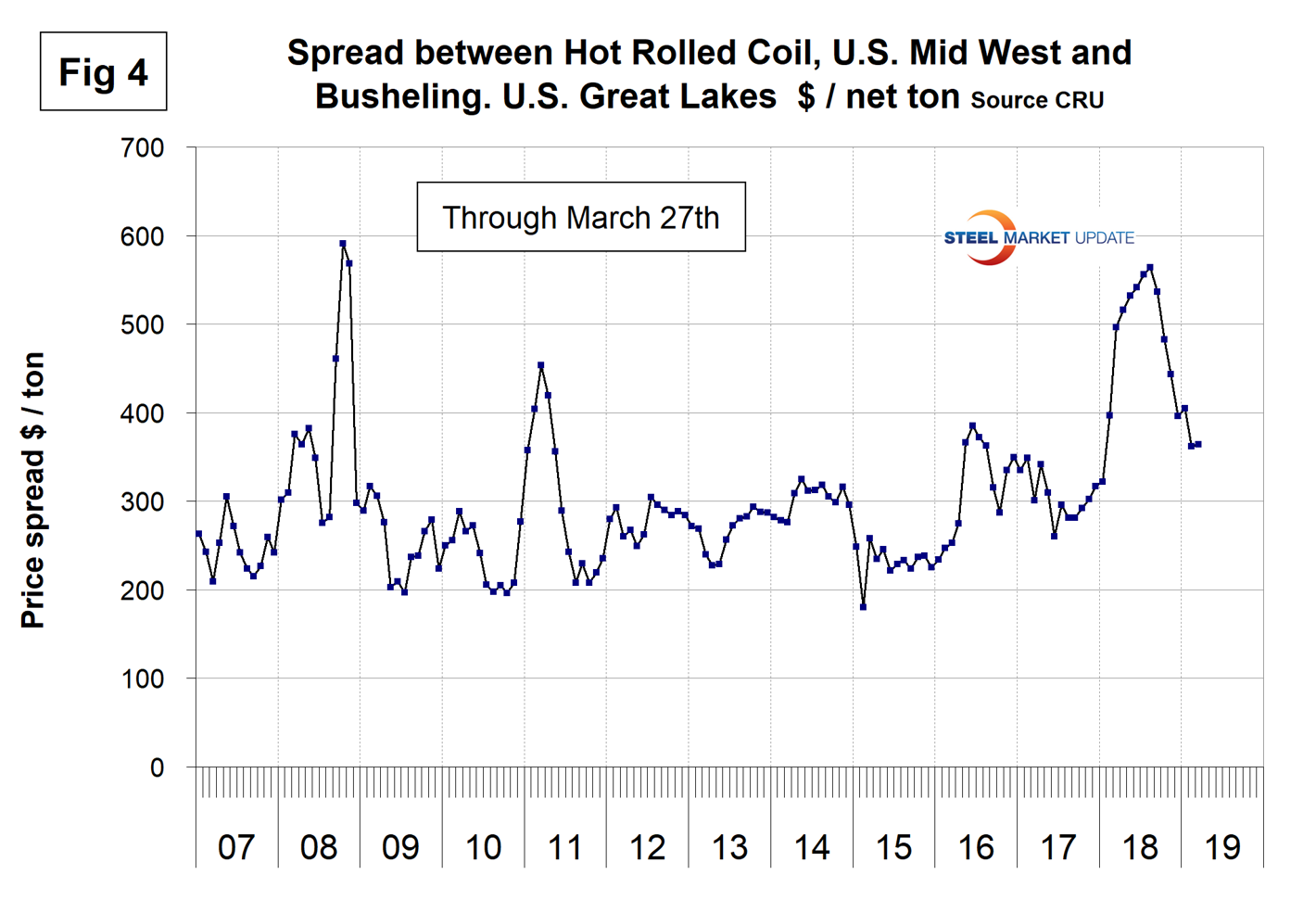
Figure 5 shows the relationship between shredded and busheling both priced in dollars per gross ton in the Great Lakes region. This spread was in the $40 to $70 range for six months prior to February and March when it declined to $25.
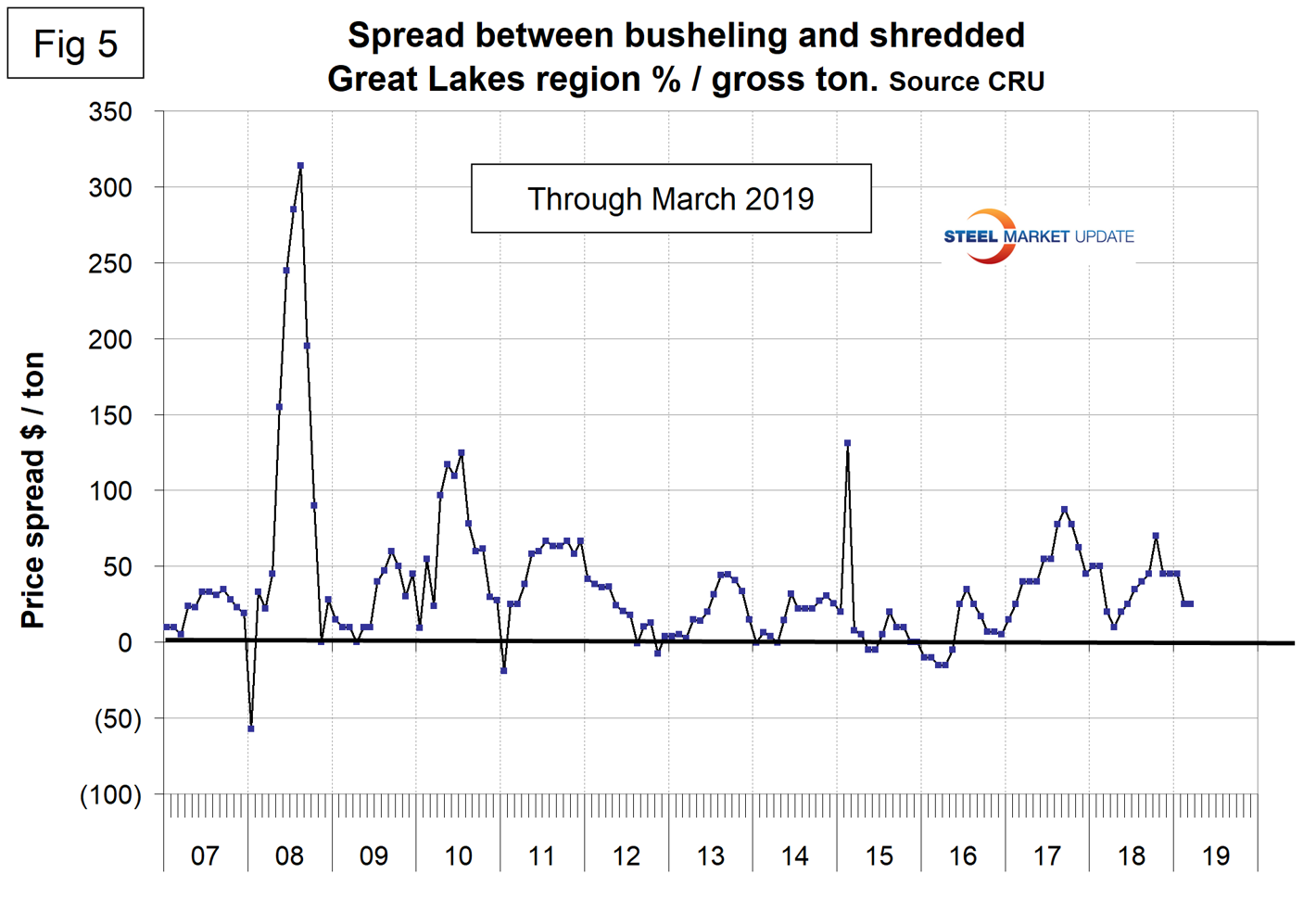
Figure 6 is a scatter gram of the price of Chicago shredded and the monthly Broad Index value of the U.S. dollar as reported by the Federal Reserve. The latest data for the monthly Broad Index was February. This is a causal relationship with a negative correlation of over 74 percent, but recent data is further from the norm than at any time in the last seven years.
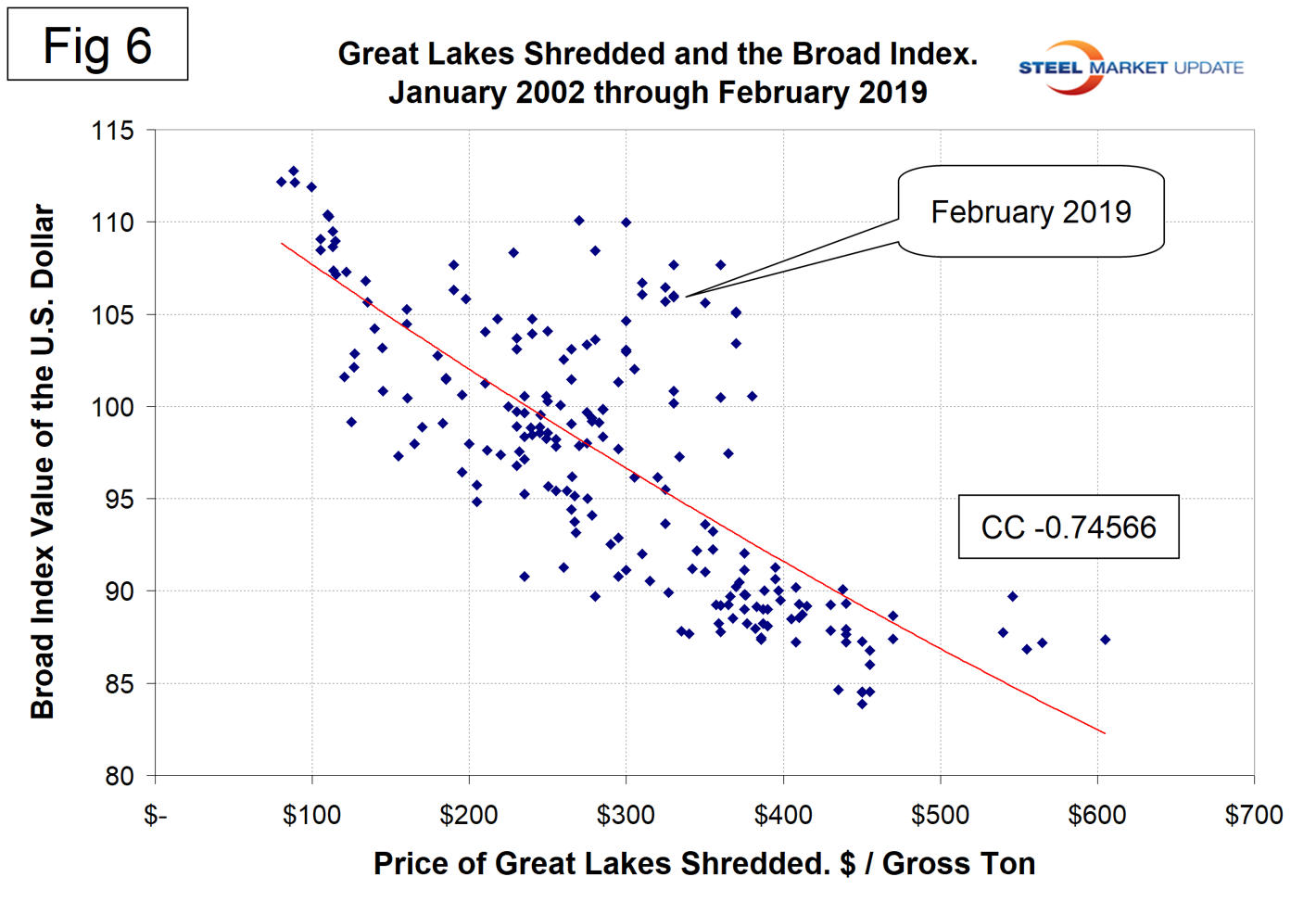
There is a long-term relationship between the prices of iron ore and scrap. Figure 7 shows the prices of 62% iron ore fines delivered N. China and the price of shredded scrap in the Great Lakes region through mid-March 2019. The correlation since January 2006 has been 81.5 percent. There has been a very unusual divergence in these prices since Q2 2017, but that discrepancy seems to be closing.
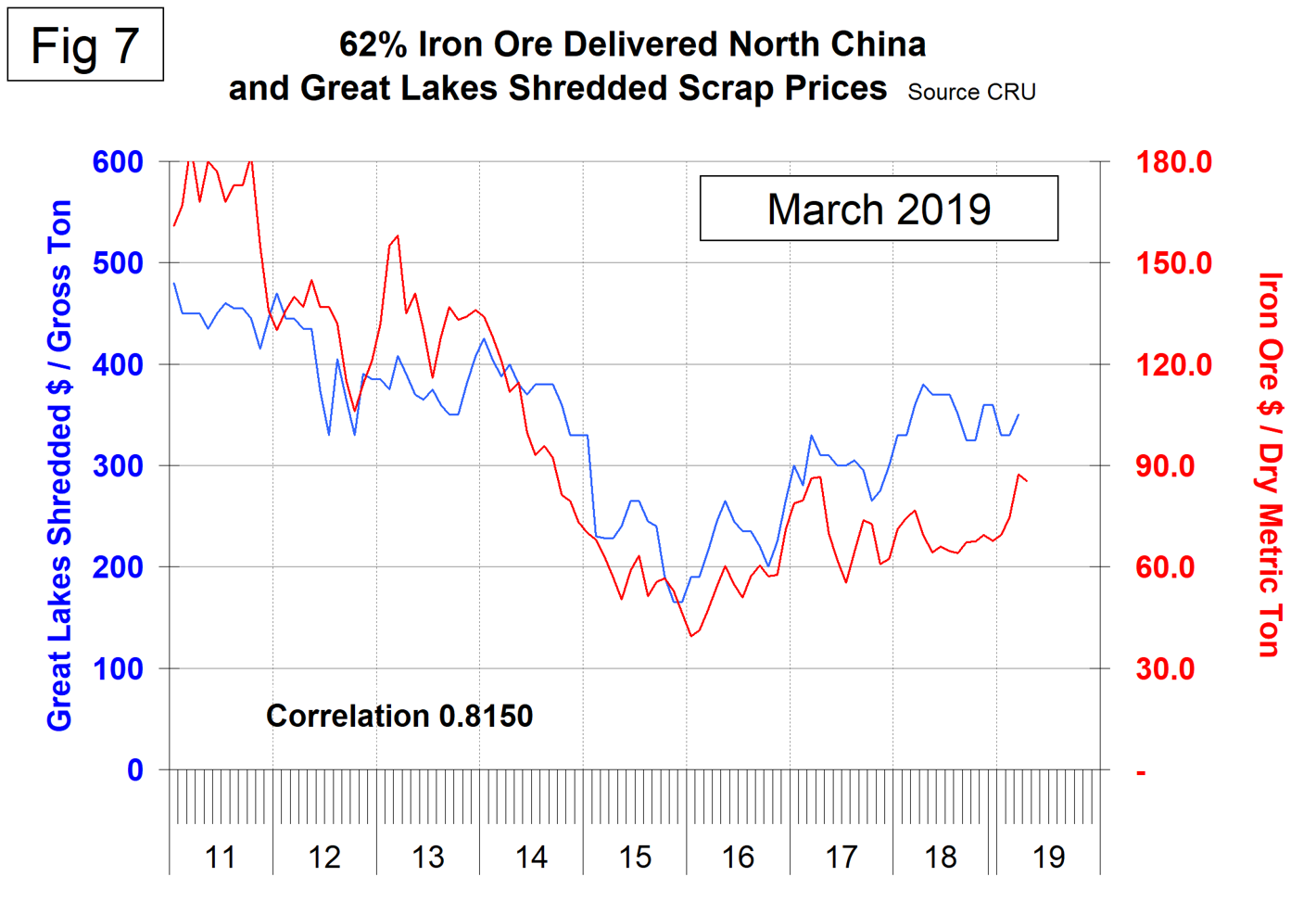
In the last 10 years, scrap in dollars per gross ton has been on average 3.5 times as expensive as ore in dollars per dry metric ton (dmt). The ratio has been erratic since mid-2014, but at 3.8 in February and 4.1 in March is coming back in line (Figure 8). Since Chinese steel manufacture is 95 percent BOF, China is more competitive on the global steel market when this ratio is high. In the last four years, there have been times when China could supply semi-finished to the global market at prices competitive with scrap.
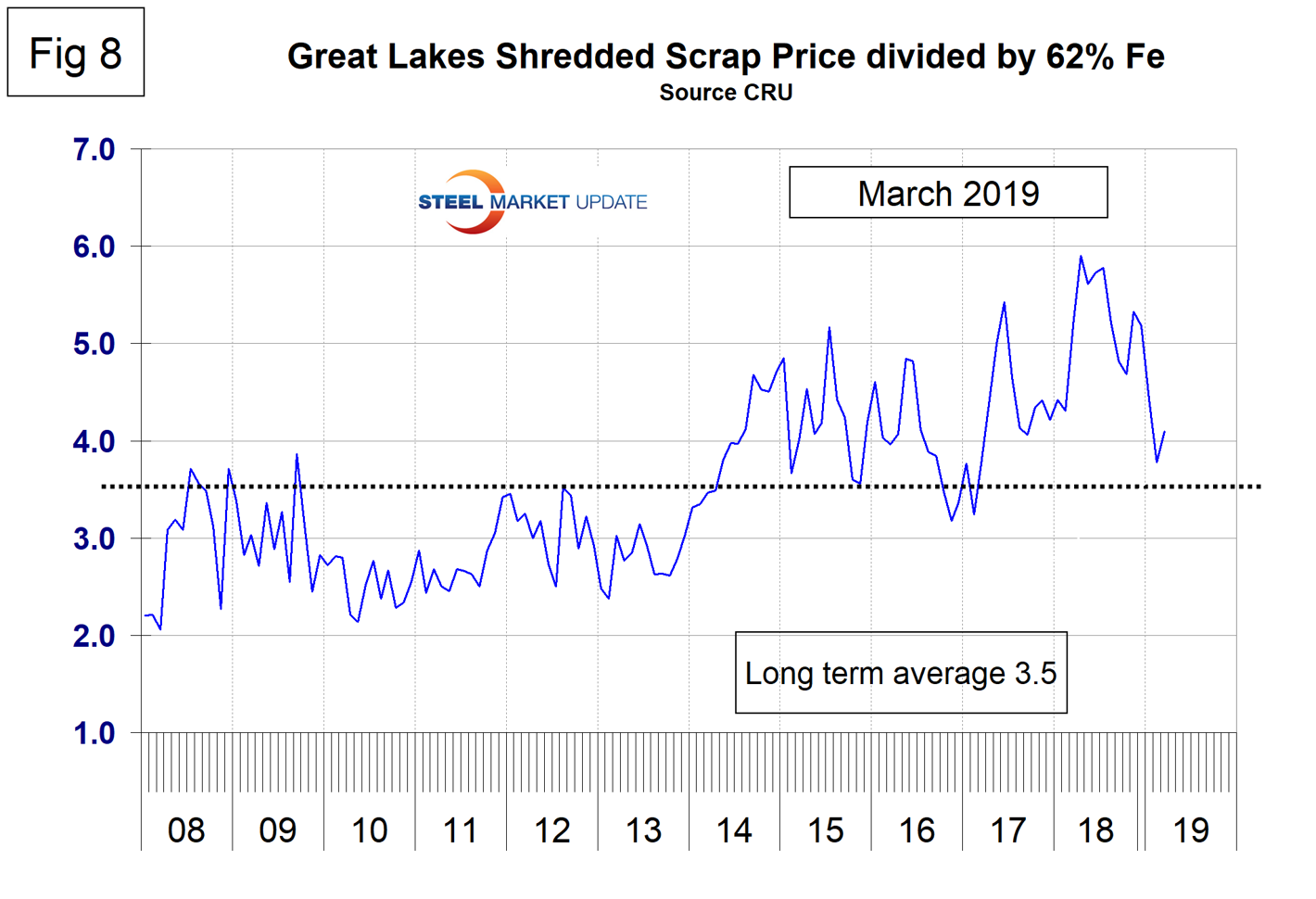
Zinc
The LME cash price for zinc mid-month is shown in Figure 9. The latest data is for March 27 when the price was $1.33 per pound and breaking out to the upside of a six-month hiatus.
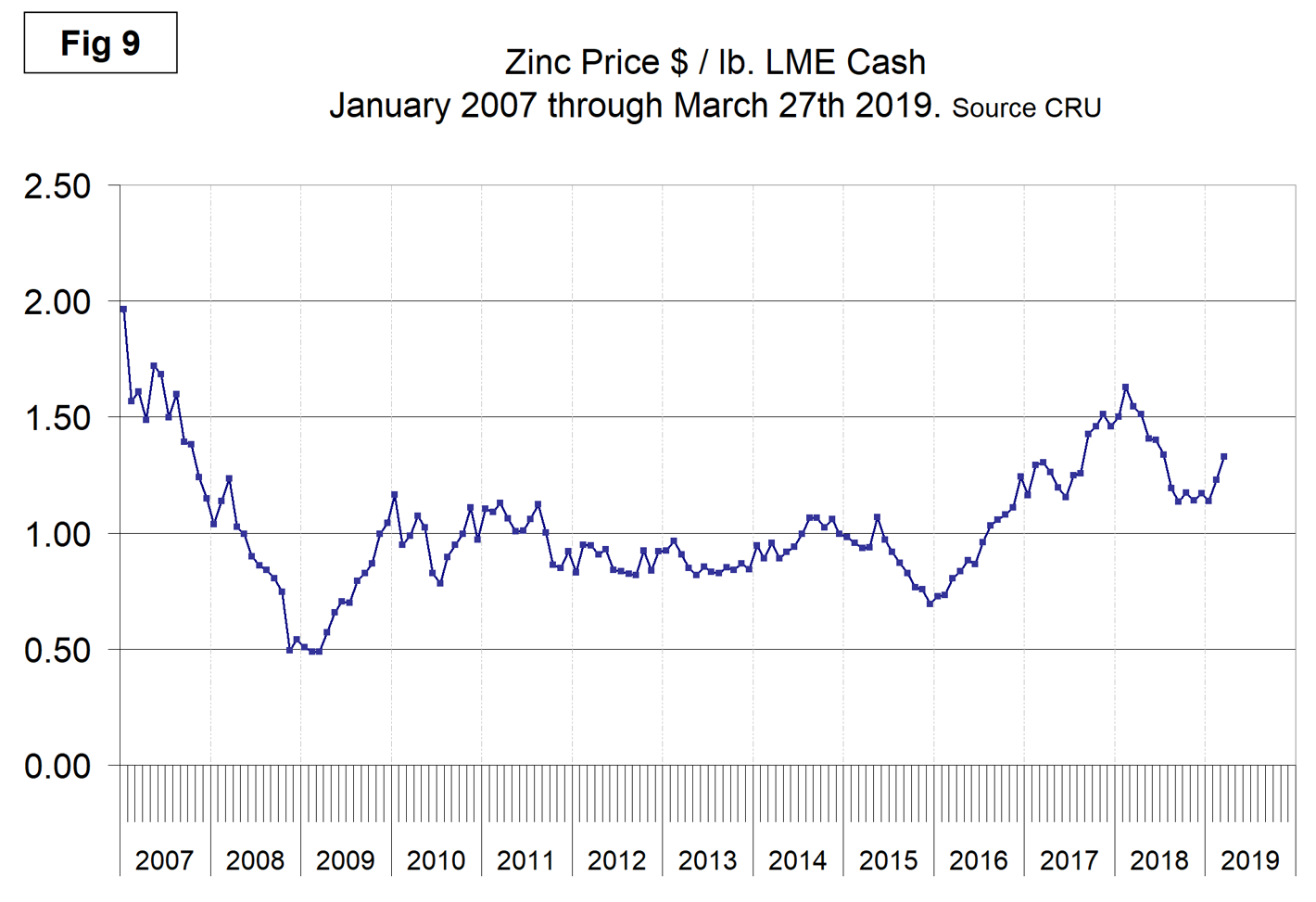
From Zinc Mining News March 20 “Zinc prices climbed to $2,845 a tonne on Wednesday after data showed LME warehouses now hold little over 58,000 tonnes of the metal, less than two days’ worth of global consumption. Inventories are down 55% this year and are on course to arrive at levels last seen in 1990. Zinc stocks peaked in 2012 at the height of the commodities boom, reaching 1.2 million tonnes. Inventories held by the Shanghai Futures Exchange are more plentiful, but low inventories of many metals in LME-registered warehouses are helping to bolster prices despite weak economic data from top metals consumer China.
Reuters reports: “Zinc is the fourth most widely used metal in the world after iron, aluminum and copper. Its primary uses are 60 percent for galvanizing steel, 15 percent for zinc-based die castings and about 14 percent in the production of brass and bronze alloys.”
SMU Comment: After appreciating steadily throughout 2018, the dollar has declined in 2019 (Figure 10). There is an inverse relationship between commodity prices and the value of the U.S. dollar on the global currency markets, an example of which is shown for shredded scrap in Figure 6. However, the price of scrap has been completely out of whack for two years now as shown in Figure 11. Long-time subscribers will remember how proud we used to be of our scrap-to-oil relationship that had a correlation of 93 percent for over 25 years. This has also broken down in the last two years, with the scrap price currently being too high. Supply and demand fundamentals are the primary drivers of raw materials prices, but a rising dollar acts as a headwind on the price of those global commodities that are priced in dollars. In the case of scrap, something significant must be occurring below our radar screen. We would love to hear from our scrap industry subscribers on why they think long-term price relationships have broken down.
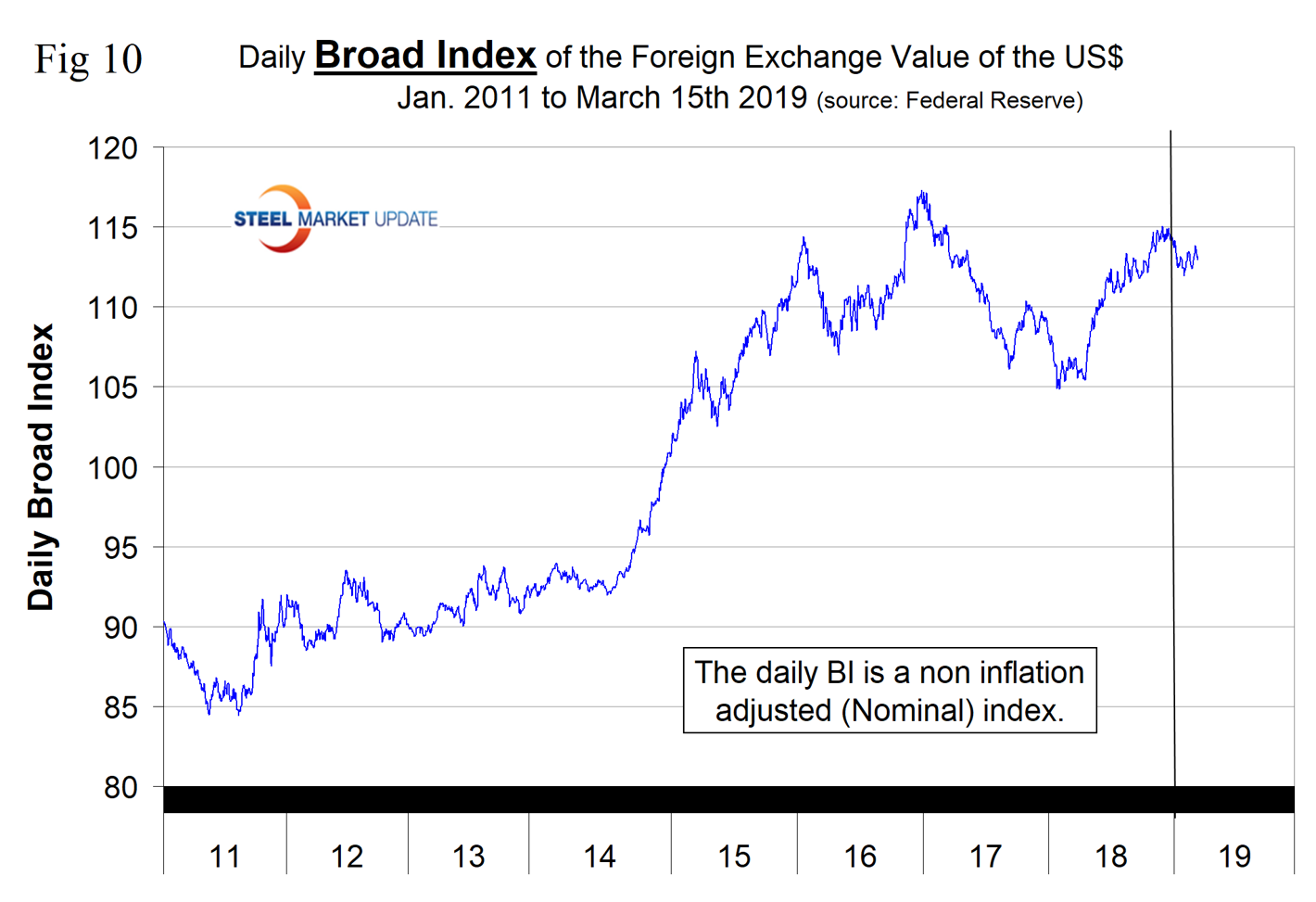
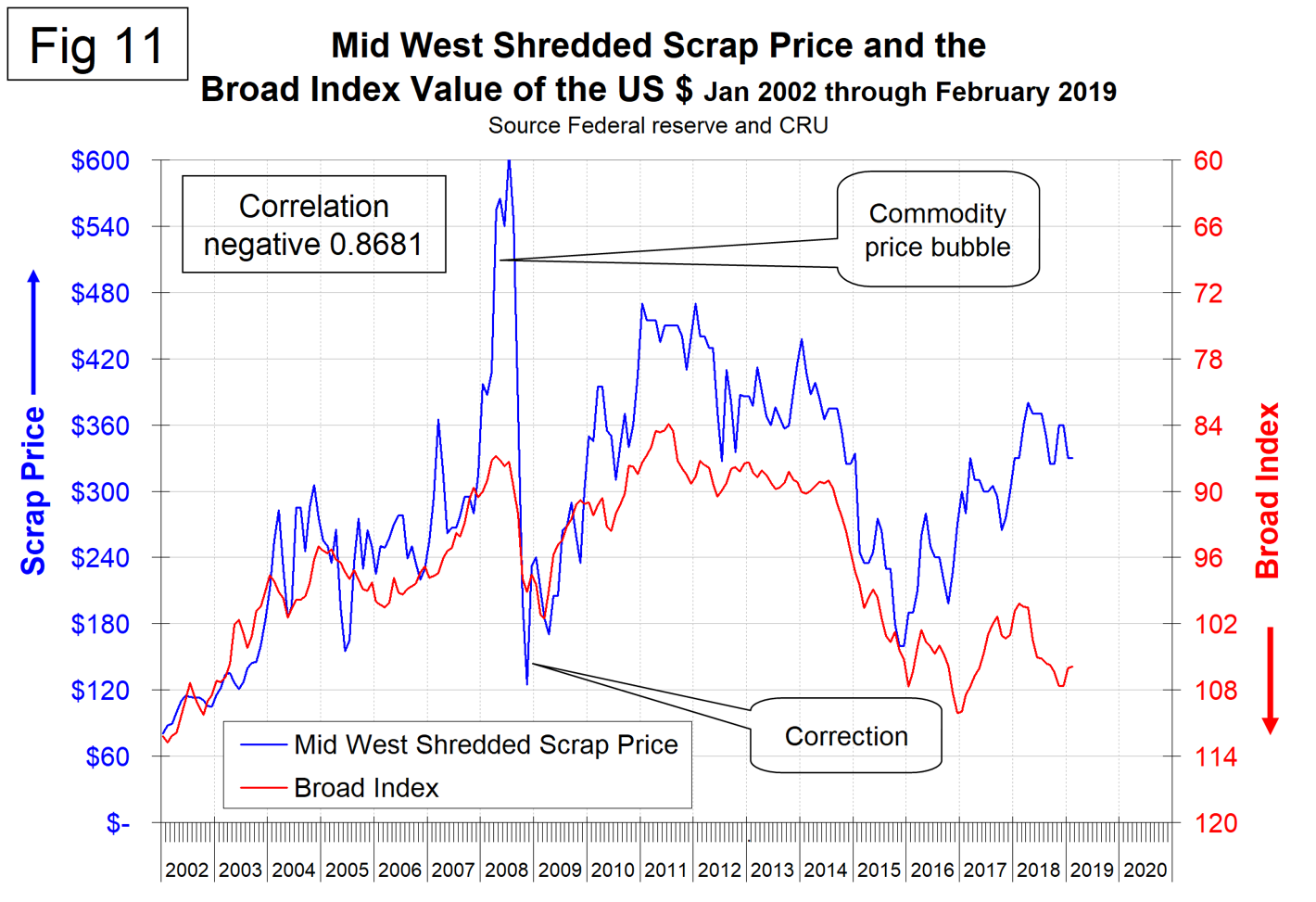

Peter Wright
Read more from Peter WrightLatest in Steel Products Prices North America

Nucor slows HRC price climb with $5/ton increase
After eight weeks of double-digit price increases on hot-rolled (HR) coil, Nucor slowed the price rise this week with an increase of $5 per short ton.

Domestic CRC prices surge ahead of imports
The price spread between stateside-produced CR and imports reached its widest margin in over a year.

Evraz raises plate prices $160/ton
Evraz North America (NA) has followed Nucor and SSAB with a plate price increase of its own: up $160 per short ton (st). The increase was effective immediately for all new orders of carbon, high-strength low-alloy, and normalized and quenched-and-tempered plate products, as well as for hot-rolled coil, the steelmaker said in a letter to […]

Nucor lifts HR coil to $820/ton
Nucor has increased its consumer spot price (CSP) for hot-rolled (HR) coil for a fourth consecutive week.

Nucor pushes HR spot price to $790/ton
Nucor increased its consumer spot price (CSP) for hot-rolled (HR) coil to $790 per short ton (st) on Monday, Feb. 10 – a $15/st bump vs. last week. The Charlotte, N.C.-based company has raised its weekly CSP by $40/st over the past three weeks after maintaining tags at $750/st since Nov. 12, according to SMU’s […]
